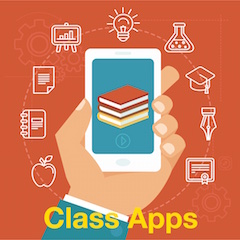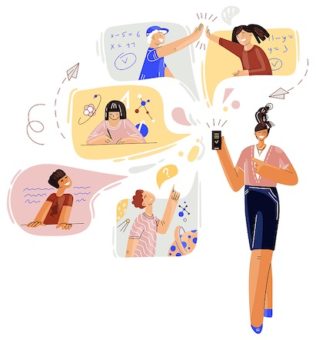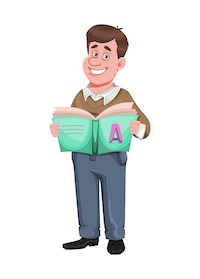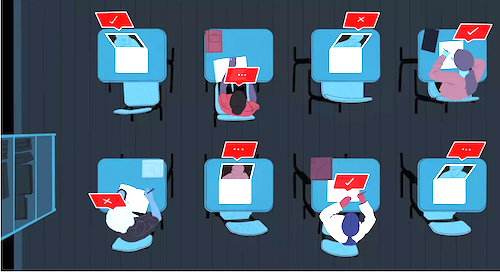Find Out Where Your Learners Are Now
A MiddleWeb Blog
 I can’t decide if this is the WORST…or the BEST time to be a brand-new teacher. Over the past few weeks I have visited with dozens of first-year educators struggling to get their “sea legs” during an unprecedented – and tumultuous – start to the semester.
I can’t decide if this is the WORST…or the BEST time to be a brand-new teacher. Over the past few weeks I have visited with dozens of first-year educators struggling to get their “sea legs” during an unprecedented – and tumultuous – start to the semester.
Novice teachers regularly grapple with the challenges posed by new curriculum, classroom management, and fostering relationships with students, families, and colleagues.
This year the pandemic is creating even more turbulence in the form of social distancing mandates, wonky school schedules, sanitization of classroom materials, and the need for flexible instruction and assignments that can pivot between face-to-face and remote learning environments.
For those of you feeling tossed to and fro in the stormy seas of instruction – be you new or seasoned sailors – know that stability and success are more likely to be attained if we focus on a few key elements this fall.
Find Out EXACTLY Where Your Learners Are As School Begins
It is crucial for each of us to notice – but not to panic – when our learners arrive in our classrooms missing essential prerequisite skills.

Our job is to start off the school year by working with our colleagues to identify potential gaps using the following steps:
- Identify the concepts and skills that were supposed to be taught from March on to the end of the school year.
- Identify the concepts and skills that were actually taught from March on to the end of the school year.
- Identifying which of those concepts/skills from steps 1 and 2 are most vital for students to get back on track in the opening weeks of the school year.
Doing so allows teachers to focus instruction and assessment on the most essential, prerequisite skills rather than spending several weeks or even months remediating in an effort to get students “caught up.” Covering everything that was missed is neither possible or necessary.
Let’s use the story of Mr. Thomas as an example…

He and his colleagues agreed that one of the first things Mr. Thomas needs to focus on is helping students demonstrate an understanding of informational texts. Specifically, his students need to be able to cite specific evidence from the text and make inferences from the passage.
When it comes to setting expectations, procedures, and engaging students, it’s important to hit the ground running in the first days of school. The same holds true when it comes to assessing learners’ readiness.
Readiness Assessment
Readiness assessment is any task designed by the teacher to collect evidence of students’ existing knowledge and abilities prior to tackling an upcoming learning experience. Doing so provides critical information about what most needs to be taught and how to differentiate to meet individual leanner needs. For example…
In order to better address his students varied readiness levels, Mr. Thomas wants to know whether and how well his students can cite specific evidence from informational texts and make inferences from a passage.

After a brief introduction to the topic, he asks his learners to take some time to read through the passage and to do their best to answer the questions he has provided them with. Half of the 8 questions provided by Mr. Thomas ask students to cite specific evidence from the article, while the other half require them to make inferences from the text.
After the activity, Mr. Thomas notices that very few of his students struggled with making inferences from the text, while nearly all of them struggled to cite relevant textual evidence. He uses this information to focus his upcoming lesson on the latter and makes a plan to address the needs of the few students who struggled in a smaller, differentiated setting.
This type of activity serves as an engaging anchor for the start of the day and doesn’t take up too much time. It also provides vital information to the teacher about the readiness level of students.
Hope for the Best…Plan for the Worst
On social media there is no shortage of skepticism about how long it will take before another COVID surge shuts schools down again. A number of schools across the country are already starting off the school year with remote learning options only for students.
This will mean that many teachers – including brand-new teachers – face the challenge of establishing routines and fostering class culture with kiddos they may have never met in person.
Most educators, however, will start off the year with at least some face-to-face interaction with their learners. Never before has instructional time been so precious. Educators must take full advantage of these potentially scarce minutes by making one-to-one connections, communicating clear objectives, engaging students in challenging/relevant learning tasks, and providing clear feedback to learners.
From the first day of class, there is also a dire need to develop the technology proficiency of our students in Google Classroom, Schoology, Canvas or whatever platform is being used by the school.
If we are very lucky, the pandemic will be kept at bay, and schools will remain open some or all of the school year. In this case, a technology platform utilized by the teacher and students can serve as a valuable tool for learners to submit work, collaborate with peers, and to access materials and tutorials in and outside of the physical classroom.

If, however, COVID ends up shuttering your school, the technology platform used in class serves as a safety net for instruction. Students’ familiarity with the technology will make all the difference in their ability to continue learning from a distance.
That’s why it’s imperative that teachers make technology an essential component of teaching and learning right now, whether or not it becomes the primary means of instruction.
The New Normal
While each school year brings its own challenges, this will be a year to remember. As teachers and students return to school, classroom routines as we have known them will be disengaged if not obsolete, and instruction will be more critical than ever.
Optimism about the future and confidence in our ability to help students succeed has less to do with COVID than it does with our willingness to do three things: (1) work with our colleagues to identify the most critical knowledge/skills to teach; (2) figure out exactly where are students are; and (3) use technology and any available face-o-face class time to help prepare them for more success, whatever the coming months may bring.
References
Caspersen, J., & Raaen, F. D. (2014). Novice teachers and how they cope. Teachers and Teaching, 20(2), 189-211.
Shafer, S. Teaching and Learning in the Pandemic. Education Week. Retrieved August 14, 2020: https://www.edweek.org/ew/issues/reopening-schools/teaching-and-learning-in-the-pandemic.html
Strom, K. J., Dailey, A., & Mills, T. (2018). Nonlinear Negotiations: Constructing Practice as a First-Year Teacher. Teacher Education Quarterly, 45(3), 7-28.
Tomlinson, C. A., & Moon, T. R. (2013). Assessment and student success in a differentiated classroom. ASCD.


































